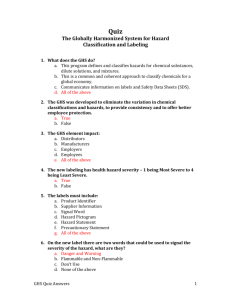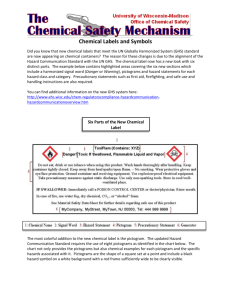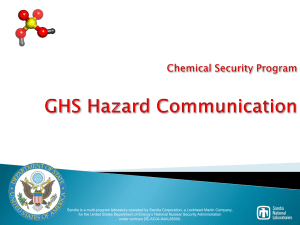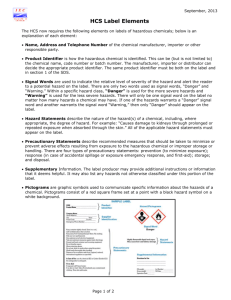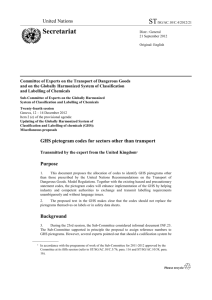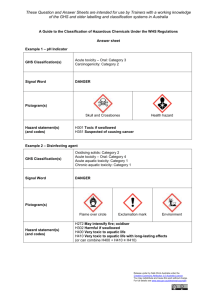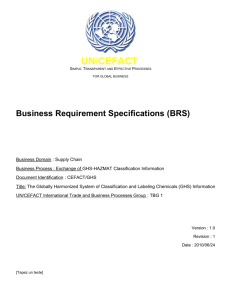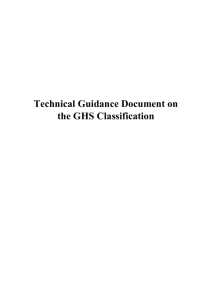SCSU Global Harmonized System poster
advertisement
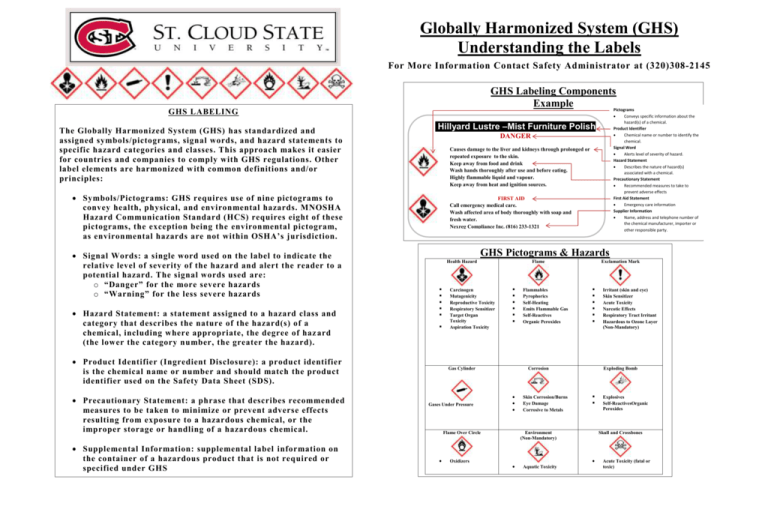
Globally Harmonized System (GHS) Understanding the Labels For More Information Contact Safety Administrator at (320)308-2145 GHS Labeling Components Example Pictograms GHS LABELING The Globally Harmonized System (GHS) has standardized and assigned symbols/pictograms, signal words, and hazard statements to specific hazard categories and classes. This approach makes it easier for countries and companies to comply with GHS regulations. Other label elements are harmonized w ith common definitions and/or principles: Hillyard Lustre –Mist Furniture Polish DANGER Causes damage to the liver and kidneys through prolonged or repeated exposure to the skin. Keep away from food and drink Wash hands thoroughly after use and before eating. Highly flammable liquid and vapour. Keep away from heat and ignition sources. Symbols/Pictograms: GHS requires use of nine pictograms to convey health, physical, and environmental hazards. MNOSHA Hazard Communication Standard (HCS) requires eight of these pictograms, the exception being the environmental pictogram, as environmental hazards are not within OSHA’s jurisdiction. Signal Words: a single word used on the label to indicate the relative level of severity of the hazard and alert the reader to a potential hazard. The signal words used are: o “Danger” for the more severe hazards o “Warning” for the less severe hazards Hazard Statement: a statement assigned to a hazard class and category that describes the nature of the hazard(s) of a chemical, including where appropriate, the degree of haz ard (the lower the category number, the greater the hazard). FIRST AID Call emergency medical care. Wash affected area of body thoroughly with soap and fresh water. Nexreg Compliance Inc. (816) 233-1321 GHS Pictograms & Hazards Health Hazard Product Identifier (Ingredient Disclosure): a product identifier is the chemical name or number and should match the product identifier used on the Safety Data Sheet (SDS). Precautionary Statement: a phrase that describes recommended measures to be taken to minimize or prevent adverse effects resulting from exposure to a hazardous chemical, or the improper storage or handling of a hazardous chemical. Supplemental Information: supplemental label information on the container of a hazardous product that is not required or specified under GHS . Supplier Identification: The name, address and telephone number of the manufacturer or supplier of the product should be provided on the label. Conveys specific information about the hazard(s) of a chemical. Product Identifier Chemical name or number to identify the chemical. Signal Word Alerts level of severity of hazard. Hazard Statement Describes the nature of hazard(s) associated with a chemical. Precautionary Statement Recommended measures to take to prevent adverse effects First Aid Statement Emergency care information Supplier Information Name, address and telephone number of the chemical manufacturer, importer or other responsible party. Carcinogen Mutagenicity Reproductive Toxicity Respiratory Sensitizer Target Organ Toxicity Aspiration Toxicity Flame Gas Cylinder Gases Under Pressure Oxidizers Corrosion Flame Over Circle Flammables Pyrophorics Self-Heating Emits Flammable Gas Self-Reactives Organic Peroxides Exclamation Mark Skin Corrosion/Burns Eye Damage Corrosive to Metals Exploding Bomb Environment (Non-Mandatory) Explosives Self-ReactivesOrganic Peroxides Skull and Crossbones Aquatic Toxicity Irritant (skin and eye) Skin Sensitizer Acute Toxicity Narcotic Effects Respiratory Tract Irritant Hazardous to Ozone Layer (Non-Mandatory) Acute Toxicity (fatal or toxic)
